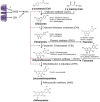Ultraviolet Radiation From a Plant Perspective: The Plant-Microorganism Context
- PMID: 33384704
- PMCID: PMC7769811
- DOI: 10.3389/fpls.2020.597642
Ultraviolet Radiation From a Plant Perspective: The Plant-Microorganism Context
Abstract
Ultraviolet (UV) radiation directly affects plants and microorganisms, but also alters the species-specific interactions between them. The distinct bands of UV radiation, UV-A, UV-B, and UV-C have different effects on plants and their associated microorganisms. While UV-A and UV-B mainly affect morphogenesis and phototropism, UV-B and UV-C strongly trigger secondary metabolite production. Short wave (<350 nm) UV radiation negatively affects plant pathogens in direct and indirect ways. Direct effects can be ascribed to DNA damage, protein polymerization, enzyme inactivation and increased cell membrane permeability. UV-C is the most energetic radiation and is thus more effective at lower doses to kill microorganisms, but by consequence also often causes plant damage. Indirect effects can be ascribed to UV-B specific pathways such as the UVR8-dependent upregulated defense responses in plants, UV-B and UV-C upregulated ROS accumulation, and secondary metabolite production such as phenolic compounds. In this review, we summarize the physiological and molecular effects of UV radiation on plants, microorganisms and their interactions. Considerations for the use of UV radiation to control microorganisms, pathogenic as well as non-pathogenic, are listed. Effects can be indirect by increasing specialized metabolites with plant pre-treatment, or by directly affecting microorganisms.
Keywords: UV-C; plant-microorganism interaction; plants; ultraviolet; ultraviolet-A; ultraviolet-B.
Copyright © 2020 Vanhaelewyn, Van Der Straeten, De Coninck and Vandenbussche.
Conflict of interest statement
The authors declare that the research was conducted in the absence of any commercial or financial relationships that could be construed as a potential conflict of interest. The handling editor declared a past co-authorship with one of the authors FV.
Figures


Similar articles
-
Terrestrial ecosystems, increased solar ultraviolet radiation, and interactions with other climate change factors.Photochem Photobiol Sci. 2007 Mar;6(3):252-66. doi: 10.1039/b700019g. Epub 2007 Feb 1. Photochem Photobiol Sci. 2007. PMID: 17344961 Review.
-
A perspective on ecologically relevant plant-UV research and its practical application.Photochem Photobiol Sci. 2019 May 15;18(5):970-988. doi: 10.1039/c8pp00526e. Photochem Photobiol Sci. 2019. PMID: 30720036 Review.
-
The role of UV-B radiation in aquatic and terrestrial ecosystems--an experimental and functional analysis of the evolution of UV-absorbing compounds.J Photochem Photobiol B. 2002 Feb;66(1):2-12. doi: 10.1016/s1011-1344(01)00269-x. J Photochem Photobiol B. 2002. PMID: 11849977
-
Plant responses to UV-B radiation: signaling, acclimation and stress tolerance.Stress Biol. 2022 Dec 5;2(1):51. doi: 10.1007/s44154-022-00076-9. Stress Biol. 2022. PMID: 37676395 Free PMC article. Review.
-
Hormone-controlled UV-B responses in plants.J Exp Bot. 2016 Aug;67(15):4469-82. doi: 10.1093/jxb/erw261. Epub 2016 Jul 8. J Exp Bot. 2016. PMID: 27401912 Review.
Cited by
-
Nitric oxide: A core signaling molecule under elevated GHGs (CO2, CH4, N2O, O3)-mediated abiotic stress in plants.Front Plant Sci. 2022 Nov 1;13:994149. doi: 10.3389/fpls.2022.994149. eCollection 2022. Front Plant Sci. 2022. PMID: 36407609 Free PMC article. Review.
-
Integrated network analyses identify MYB4R1 neofunctionalization in the UV-B adaptation of Tartary buckwheat.Plant Commun. 2022 Nov 14;3(6):100414. doi: 10.1016/j.xplc.2022.100414. Epub 2022 Aug 2. Plant Commun. 2022. PMID: 35923114 Free PMC article.
-
A Plastic Biosynthetic Pathway for the Production of Structurally Distinct Microbial Sunscreens.ACS Chem Biol. 2023 Sep 15;18(9):1959-1967. doi: 10.1021/acschembio.3c00112. Epub 2023 Aug 21. ACS Chem Biol. 2023. PMID: 37603862 Free PMC article.
-
Origin and Function of Structural Diversity in the Plant Specialized Metabolome.Plants (Basel). 2021 Nov 6;10(11):2393. doi: 10.3390/plants10112393. Plants (Basel). 2021. PMID: 34834756 Free PMC article. Review.
-
Fungi beyond limits: The agricultural promise of extremophiles.Microb Biotechnol. 2024 Mar;17(3):e14439. doi: 10.1111/1751-7915.14439. Microb Biotechnol. 2024. PMID: 38478382 Free PMC article. Review.
References
-
- Aires A., Mota V. R., Saavedra M. J., Monteiro A. A., Simoes M., Rosa E. A. S., et al. (2009). Initial in vitro evaluations of the antibacterial activities of glucosinolate enzymatic hydrolysis products against plant pathogenic bacteria. J. Appl. Microbiol. 106 2096–2105. 10.1111/j.1365-2672.2009.04181.x - DOI - PubMed
Publication types
LinkOut - more resources
Full Text Sources

